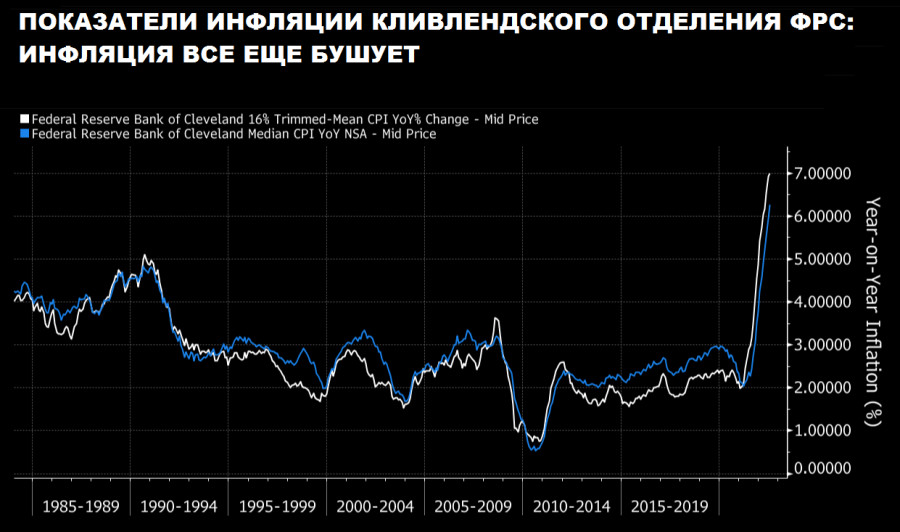More recently, the US government has reported a good achievement in the fight against inflation. The indicators of the latter fell by 0.6% from the June level, which was a pleasant surprise for all economists. Traders immediately reacted by increasing their bets for the bull market. But everything is not as simple as it seems to market optimists.
Traders are losing their heads over good inflation news
The headline inflation rate in the US for July was 8.5%, which is lower than the 9.1% registered in June, and also lower than almost all analysts predicted. The streak of unexpectedly strong performances, as prices continued to rise and inflationary pressures mounted, was broken. Many analysts, including Robert Burgess, are quick to trumpet the news that the peak of general inflation, including food, fuel and everything else, is behind us and "it's time to buy."
However, a number of indicators still do not look so rosy and make you at least think that the hole is far from being passed. While this CPI report is undeniably positive, it is not a game-changer and is unlikely to have much of an impact on the behavior of the Federal Reserve before the end of the year, I'll show you why.
Yes, no doubt, temporary inflation is indeed transient.
Recessionary surges in various products that were most directly affected by the pandemic, expected a year ago, have finally made their way through the system. Fuel prices, used and rental cars, and airline tickets have all experienced huge volatility since the pandemic, and this has been exacerbated by companies' insane inventory policies.
Now the surge in prices is greater than 12 months ago. Rental car inflation, which at one point exceeded 100%, has now turned negative. Used car inflation has dropped to single digits. Fuel and airfare prices remain elevated but below their highs. There is every reason to expect that these inflation figures will also continue to improve.
Except for fuel, they are all included in the standard "core" inflation, which showed the lowest monthly increase since September last year. So at first glance, everything looks good enough.
However, there is a strong sense that temporary effects are making this core figure look lower than it really is after months of looking higher. After all, all these categories have a strong seasonal influence.
Factors that have misled the markets
To put it bluntly, the pandemic, now in its third year, has taught us that summer is traditionally the low season for coronavirus infections. While autumn and winter show sharp spikes. It looks like people just decided to spend this summer to the fullest - in anticipation of a new surge that is already looming on the threshold.
Restraint over the past two years is causing people to spend more now in an attempt to have time to rest before the end of the season. This affects all categories of goods, increasing the demand for car rentals and housing, hotel services and services in general. However, this is clearly a temporary effect that will disappear in October, replaced by another wave of gloom over the expensive heating season and the outbreak of a new strain of Covid-19.
Specifically, Standard Chartered PLC's Steven Englander has compiled a chart of adjusted basic goods – excluding goods most directly affected by the pandemic. It turned out that the indicator is still declining... but not so impressive anymore. Making it seem that the deferred demand is making small adjustments so far, but this is a temporary effect.
The main problem is not in the charts, but in the fact that this very increase in prices had nothing to do with monetary policy, so there was little the Fed could do to control them.
The majority of commodities that are included in the calculation of core inflation were not affected by these effects. So various research teams at the Fed are tracking the core of inflation to examine underlying price pressures – and those numbers are still rising. Perhaps we are at or near the peak, although I personally believe that we will reach the peak in November-January, but we have not overcome it even close.
To verify this, you just need to take other basic indicators. For example, a pair of widely used numbers from the Fed Bank of Cleveland, which publishes a trimmed mean (eliminating the largest spikes in either direction and taking the average) and the median. These metrics never use rental car or fuel data. And unfortunately, both indicators continued to grow in July, and both are at the highest level since the beginning of measurements by these methods in 1984, exceeding the 1991 highs by almost twice. Although if we take a monthly cut, then the July one looks quite good, having decreased by as much as 40% from the June highs.
But the most revealing method, in my opinion, is tracking sticky prices, which is traditionally performed by the Fed Bank of Atlanta. These goods require long planning to change their prices and are difficult to correct (compared to flexible prices that can rise or fall quickly without much difficulty).
We have already said that in the first months of inflationary panic, flexible prices prevailed, for which inflation is already starting to decline slightly. But this is a very unreliable basis, since they can rise at any moment, following the trends of the market.
What's really important to us is that manufacturers' expectations have shifted so much that sticky prices are moving. Once again, the annual rate of severe price inflation rose last month to a new 40-year high. This is a big problem that requires extreme vigilance on the part of the central bank.
The good news is that sticky prices didn't inflate as much last month as they did last month, but it's still strong evidence that the Fed doesn't think the peak has yet arrived, and that's what I'm leaning on when I talk about that we will feel the gravity of the situation only by winter.
Similarly, the problem of housing costs is acute, which accounts for about a third of the entire index.
Annual rent inflation, which aims to reflect changes in the cost of housing for renters and buyers, surged again last month, hitting a new high since 1990.
Despite indications that the massive increase in borrowing costs driven by the Fed's tightening to date is already having an impact on the housing market, the number is likely to continue to rise, and core inflation with it. This is typical of the post-cheap dollar era, when the currency depreciates and home prices rise simply because of this one factor. But, of course, other factors should also be taken into account: some Americans will change housing to cheaper ones due to rising utility prices and an increase in their daily expenses. This migration will support demand in the rental market, preventing prices from falling sharply.
Corridor for the Fed
Now we have to ask ourselves, what, exactly, can the Fed do about this?
Yes, preventing another negative surprise means we can eliminate any risk of sudden rate hikes that could wipe out the bulls.
As for the Treasury futures market, the netting worked here: strong wage data and encouraging inflation data, as well as lower jobless claims, offset each other. So economists are a bit at a loss: the federal funds market seems to be saying that the Fed could just as easily go along with any of the proposed rates for a raise - either 50 or 75 points - which, of course, does not make things easier for traders.
In general, the markets reacted surprisingly calmly to the "positive" news, and this in itself is already a great signal.
Against this background, the foreign exchange market suffered the most. The dollar index, comparing the currency to some of its biggest trading partners, posted its biggest percentage drop in two months, putting an end to a major July rally. This, of course, will ease the pressure on the profits of multinational corporations and will be very welcome news for the finance ministers of developing countries, giving the rest of the world a breather.
But what is the problem here?
For all the positive momentum, the Fed would like financial conditions to remain tight.
The combination of lower bond yields with a weaker currency and higher stocks has the bulls rearing their heads. So far, Bloomberg's own index, as well as the Goldman Sachs index, agree that the situation is becoming much softer. But that's exactly what the central bank doesn't want if it wants to reduce demand and curb inflation. We are indeed in a situation where the Fed is playing hard against the bulls and that speaks volumes for the near future.
So, yes, you can play against the Fed, but the US government plans to have markets help the country's economy more by making funding a little more expensive. Thus, there is no basis for a dovish reversal yet, and it is a pretty good argument to show the markets who is in charge with a 75 basis point advance next month.
So there any reason to rejoice??
This brings us to the stock market players who continue to challenge the inflation skeptics who believe that the peak of inflation has not yet come after a softer than expected report on the consumer price index for July.
We see the underlying S&P 500 gain 2.1% to its highest level since May, led by shares in economically sensitive companies such as chip makers and car makers. The Nasdaq Composite Technology Index rose 2.8%, up almost exactly 20% from its yearly low set in June. This has already been heralded in some quarters as a new bull market.
Technically, this is true. But there are serious concerns that the bottom is yet to come. For example, Sam Stovall, who serves as chief investment strategist, believes the position is unclear until the underlying index closes above 4231.66, the 50% retracement level for the current bear market. It closed at 4,210.24 on Tuesday, so the S&P needs to gain less than 1% to get there. Using Fibonacci analysis, Stovall believes reaching the midpoint will signal that the market is ready for a full recovery.
A close above that would be a clear signal that a bear market low had already been set, the strategist said, as none of the earlier bear markets since 1946 have retraced 50% of their decline only to endure a subsequent sell-off that exceeded the previous one. This does not mean that the previous low will not be challenged, but indicates that the June 16 low is likely to hold.
In total, the world economy has experienced 19 cases when, after the Second World War, the S&P 500 entered a bear market (a drop of 20% compared to the peak or a correction of 15% to 19.9%).
Of the 19 cases described, only the bear market of 1973-1974 recorded a lower low after a 50% recovery from a 15% decline. The reason was an exceptional geopolitical upheaval, during which the Arab countries invaded Israel. The result was an oil embargo - all of which erupted just after the S&P reached its 50 percent recovery. After that, it suffered a disastrous 44% drop.
However, for some technical analysts, the level worth looking at is 4177. This is where the S&P 500 peaked its rebound from May to June. Analysts call this a "higher high," as Lu Yang and Isabelle Lee explain. They believe that this is supposedly a signal that more sustainable success awaits us.
The bottom line of the deal seems to be that if the market goes further up, it would be logical to assume that June was the bottom. While this still leaves open the question of how far the market can go, the last question depends a lot on economic fundamentals. Now strategists have very different opinions about where the stock will go. For Seema Shah, chief global strategist, this is nothing short of a textbook bear market rally: "Technical data and sentiment have driven the rally and momentum is now supporting it. Markets have become overly optimistic about the outlook for the Fed and even the economy. But as we move into the fourth quarter, earnings growth will show clear signs of struggle and inflation will decline very slowly, providing markets with an important reminder that further rate hikes are absolutely necessary. This should set the stage for a renewed market decline."
And it's hard to disagree with it
Jay Hatfield also thinks stocks could retest June lows, especially ahead of September and October, which are usually volatile months for the market.
Whatever the outlook, the September FOMC meeting will be a key moment. The CPI printout prompted swap traders to cut bets on another 75 basis point rate hike in favor of a 50 basis point hike. But the stock market seems more confident about the Fed's dovish mood. Too many are confident that inflation information could dampen Fed hawkish sentiment, at least for a while, and the US economy appears less likely to face a major downturn, even before fiscal stimulus resumes. Since the Fed's increasingly hawkish tone has been a major source of concern for the US stock market, any sign that FOMC members are becoming more cautious could prolong the rally.
However, bullish sentiment should be treated with caution.
After all, before the next scheduled FOMC meeting, there will be another jobs report, another CPI report, and a Jackson Hole conference. It might be a little premature to definitively state that the stock market is recovering because it's hard to see what could propel them further. The stock rally has gone too far. Now the Fed has to destroy demand across the board to get inflation under control, and I think the stock market either doesn't fully understand or doesn't believe this or both. The S&P is in about a 50% retracement and it is clear that there are few catalysts here to move much higher. The economic news is not good, new rate hikes that make things worse, and lower savings rates and higher consumer debt all point to a significant slowdown in consumption and, ultimately, for markets to rise.
Thus, the charts suggest that the bottom may well be reached. But any reasonable economic analysis should convince you that the hard times are not over yet.























